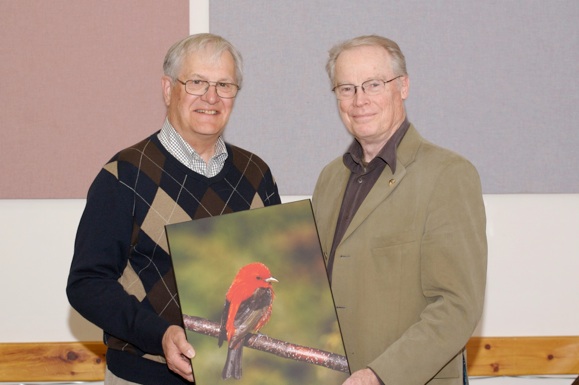By Joan and Jerry Asling
On March 27 we began our first bluebird box check of the 2010 season. Farmers were working their fields, and all the ditches were dry, which we often don’t get until late summer, and the temperature was 28C. Jerry cleaned out lots of mouse nests with his trusty tool – an egg lifter. Mouse nests are the main reason we try to get around very early in the spring. We took along small strips of wood to secure over the dropped-down ventilated sides of our old boxes. Other bluebirders have decided that more hatchlings die from cold and wet than from heat, so we tried to weather-proof our original upright boxes. We made several trips to an Amish sawmill east of Scone for 1″ thick cedar boards. We had started making a new-shaped box designed by the late George Coker of Winona and dubbed the Coker box. It is a long box with a half wall between the front and the back. The idea is that the bird on entering the box shakes off any water if it is raining in the ‘mudroom’ section and then it builds its nest and raises its young behind the half wall.
Bluebirds seemed to get the concept, but tree swallows nested in the front and were easy prey for predators. Since we had made the operating door at the back, we had to remove all the screws to take the front off, move the nest back and put blocks in the front section to discourage nesting there. This was a lot of work and time wasted in the field. We have three cordless drills, but always ran out of charge every time we went out. To rectify this problem we began building the boxes with doors both front and back.
When Jean Iron came up to speak to SFN in June she mentioned a new Coker design and sent us an e-mail of the plan. We have adapted the design to our wood supply, and the box we are now making is 6″ wide, 6″ high, 14″ long and has an 8″ wide roof that is 24″ long, and opens at the end and has no half wall. There is lots of roof overhang on the sides to keep the rain out of the seams and lots of length to thwart predators and keep precipitation out of the entrance hole. We have over 100 of these new air-tight condos ready to hang next spring. We have to replace 300 + old boxes that have been up 13-15 years and are at the end of their life. They make great campfire wood as they were made with free hardwood from the old Scone Pallet Factory.
We decided we would put 4 new boxes on metal posts at Kinghurst. We loaded our tools, stepstool, sledgehammer, 4 boxes, 4 posts onto a child’s wagon and pulled it through the trail to the fields. Hammering the posts in that rocky soil was a try and try again experience. One post was nice and solid and then we realized we’d (well, Jerry) had hammered it in upside down. Dragging that wagon in fully loaded was such a challenge and hanging the boxes was so time consuming that we were literally hauling the wagon out in the dark.
We had snow on the Mother’s Day weekend and all our nestlings except for one box died. In 2008 and 2009 we lost all our babies on the May 24th weekends. We are hoping the new box design and the thickness of the unplaned lumber will help early nestlings survive in the future. This year we also had several boxes with eggs abandoned. This probably means the female died and even if the male survived he cannot incubate the eggs. From our 460 boxes we had 58 successful bluebird nests and 143 birds fledged. Tree swallows took 168 of our boxes and fledged 681 young. House wrens nabbed 10 boxes and reared 41 young, and 3 chickadee nests produced 11 young.
Jerry and I attended the North American Bluebird Convention at the Burlington Botanical Gardens Sept 8-11th There were 105 people registered from all areas of the U.S. and Canada. Some only had 6 or 10 boxes. Only one had more than us with 700 +. There were guests speaking on Prothonotary Warblers, Cavity Nesters in B.C., Trumpeter Swans, Chimney Swifts, Wood Thrushes, Peregrine Falcons and of course the Eastern Bluebird. The survival of all of these species has been threatened and people are working on recovery programs for all of them.
Jerry and I are happy to be part of the Eastern Bluebird recovery. For 4 1/2 months from April to August we spend most of our time repairing, re-hanging, constructing and checking our trail boxes. We are constantly losing boxes and habitat because of fence post removal and less and less pastureland. If you or anyone you know has suitable habitat – large lawn, pasture, orchard etc. and would be interested in having a couple of boxes please let us know.



